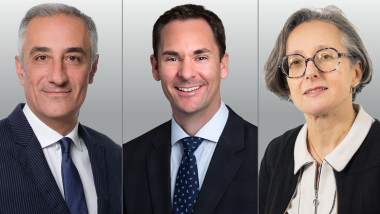Why Everyone’s Talking About… Stagflation
Defined as a period of slow economic growth or stagnation coupled with high inflation, this painful economic condition hasn’t been experienced for many years. Even after the Global Financial Crisis, there was very little inflation to speak of2 and economic growth was relatively healthy, even if not particularly strong3.
But the changing economic backdrop of late is sparking fears that a stagflationary environment is on the horizon once again. Around two-thirds (65%) of respondents to a recent Natixis survey highlight it as a concern4.
Fund managers are also getting nervous about its spectre. In March, some 88% of respondents to the Bank of America’s keenly watched Fund Manager Survey predicted a stagflation environment for markets in the coming 12 months5.
A supply shock is one of the biggest triggers. In the past, it has been ignited by rapid increases in oil prices. Higher oil prices can slow economic growth as energy costs cut into profits and make production more expensive.
Bad government policy is another key trigger. For example, stricter regulation of markets, goods and labour can worsen inflation or further impact economic growth.
It can be difficult for governments and central banks to prevent or control stagflation, however. This is because many of the policy tools available to combat high unemployment, for example, can exacerbate inflation and vice versa.
In such an environment, investors may be forced to find ways to protect their portfolios through stock selection6 and greater diversification into areas such as alternative assets7 or ‘safe havens’ like gold8.
These concerns were exacerbated by the withdrawal of generous fiscal support implemented during the pandemic and moves to raise interest rates to more normalised levels after more than a decade at ultra-low levels. Then in 2022, energy markets were sent into a spin as the US, UK, EU, and others, enforced sanctions on Russia following its invasion of Ukraine.
All the ingredients required for a stagflationary environment have therefore been in place for some time. However, the macroeconomic backdrop means that many of the tools usually available to central banks and governments to combat stagflation remain out of reach or are politically impossible.
In 1973, the global economy suffered a huge supply shock as the Saudi Arabia-led oil cartel OPEC placed an oil embargo on countries that supported Israel against Egypt during the Arab-Israeli War. Prices spiked as a result. And this came at a time when money supply for countries such as the US and UK was also fairly loose, which could have supported more inflation.
In response, some governments and central banks began raising rates – which remained at high levels well into the 1980s – to try to tame inflation as economic growth recovered9.
Other instances of stagflation can be found throughout history, even though the term may not have been formally coined to explain the phenomenon.
Higher energy prices and supply chain disruptions have been pushing inflation higher across the board in recent months, and prices remain stubbornly high in many geographies. Nevertheless, central banks – such as the Federal Reserve, Bank of England and European Central Bank – continue to target lower inflation through interest rates.
Many of the economic commentators recommend focusing on tackling inflation before trying to focus on reigniting the economy. One is Mohamed El-Erian, chief economic advisor at insurer Allianz and former chief executive at asset manager PIMCO. He recently encouraged the Federal Reserve to continue focusing on reducing inflation rather than bowing to pressure to cut rates11.
“The flashing red light resulting from a speed-of-light run on the US banking system, or what economists broadly refer to as financial contagion, is behind us,” noted El-Erian. “Yet it is too early for policymakers to declare mission accomplished.”
He continued: “Instead, red has become a flashing yellow due to the slower-moving economic contagion whose main transmission channel, that of curtailed credit extension to the economy, increases the risk not just of recession but also of stagflation.”
However, US economist and Nobel prize winner Paul Krugman said last year’s ‘Summer of Stagflation’, and dire warnings about what’s needed to combat inflation, never came to fruition12.
“Inflation pessimists were admirably clear about their data and assumptions,” he said. “But there was, and is, a mindset — possibly affecting economists themselves, definitely affecting much of their audience — that is always ready to see any economic setback as a replay of that ’70s show, that always sees stagflation looming.”
Indeed, Krugman warned that the Fed could risk an “unnecessary recession” if it maintains its hawkish policy stance in response to “imaginary stagflation”.
- Bull market – stock prices on the market overall are rising; as opposed to a bear market, where there is a downturn.
- Defensive stock – an equity security that has the capacity to provide a dividend and stable earnings regardless of the state of the overall stock market.
- Hawkish policy stance – Central banks, like the US Federal Reserve (the Fed), typically have two key objectives: control inflation and maximize employment. However, these goals will often be at odds with one another. They are often referred to as being 'hawkish' or 'dovish', therefore, depending on their differing views on what monetary policy position the economy requires at that time. A hawkish Fed will prioritise keeping inflation low or getting it lower. It’s likely to raise interest rates even if that causes job losses. On the other hand, a dovish Fed seeks to lower interest rates or keep them low, because loose monetary policy increases the money supply and supports economic growth.
- Monetary policy cycle – Refers to the cyclical pattern of increasing and decreasing the money supply by adjusting interest rates or using other economic stimulus.
- Quantitative easing (QE) – also known as large-scale asset purchases, QE is a monetary policy stance whereby a central bank buys predetermined amounts of government or Treasury bonds, or other financial assets like agency mortgage-backed securities, to inject liquidity directly into the economy and help keep interest rates low. It sometimes refers specifically to the US government's QE programme that was in place from December 2008 through to October 2014.
- Soft landing – A moderate economic slowdown following a period of growth. The Fed and other central banks aim for a soft landing when they raise interest rates to curb inflation. But the Fed has a mixed record in accomplishing a soft landing during past rate hiking cycles. The likelihood of a soft landing is reduced by the time lags associated with monetary policy.
2 Source: World Bank, https://data.worldbank.org/indicator/FP.CPI.TOTL.ZG?end=2019&start=2008
3 Source: World Bank, https://data.worldbank.org/indicator/NY.GDP.MKTP.KD.ZG?end=2019&start=2008
4 Source: Natixis Institutional Investor Survey 2023, https://www.im.natixis.com/intl/research/institutional-investor-survey-2023-outlook
5 Source: BofA Global Fund Manager Survey 2023, Bloomberg.
6 Source: Business Insider, https://markets.businessinsider.com/news/stocks/stock-market-outlook-stagflation-economy-volatility-bonds-inflation-blackrock-etfs-2022-8
7 Source: Official Monetary and Financial Institutions Forum, https://www.omfif.org/2022/12/flight-to-safety-versus-fight-for-returns/
8 Source: Gold.org, https://www.gold.org/goldhub/gold-focus/2022/03/stagflation-strikes-back
9 Source: Time Magazine, https://time.com/6160043/ukraine-oil-1970s-stagflation/
10 Source: Project Syndicate, https://www.project-syndicate.org/commentary/stagflationary-debt-crisis-is-here-by-nouriel-roubini-2022-10
11 Source: Financial Times, https://www.ft.com/content/9722fd18-129e-488e-b422-077f26c0ba2e
12 Source: New York Times, https://www.nytimes.com/2023/02/06/opinion/inflation-summer-stagflation-economy-recession.html




 Why Everyone’s Talking About… Market Bubbles
Why Everyone’s Talking About… Market Bubbles
 Equities: How worried should we be about valuations?
Equities: How worried should we be about valuations?
 Global Corporate Bonds – Attractive Yields but Thin Risk Premium
Global Corporate Bonds – Attractive Yields but Thin Risk Premium
